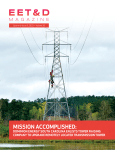
As the world’s population grows, so does the amount of energy people consume, and utilities have always been tasked with figuring out how to meet those increased energy demands. Meanwhile, utilities also must be ever watchful of the latest trends and advancements in technology that will allow them to compete and grow at the same pace as the rest of the power sector. Simultaneously, utilities must continue maintaining existing infrastructure, while dedicating the resources necessary to modernize the power grid.
Because of so much happening with technology, training, processes and policies, it is likely that most industry partners in the electric power sector are involved with some aspect of the modernization of the power grid. In this issue, we feature some of the efforts underway to meet grid modernization goals.
Grid modernization and broadband access
In her article, Bobbie Harris, who is the executive director of the United Broadband Alliance (UBBA), talks about paving the way for grid modernization. Harris reminds us that the COVID-19 pandemic accelerated the need for easy access to high-speed internet. Without such access, it made it difficult for people to work remotely, attend school online or stay connected virtually to friends and family. According to research cited by Harris, 42 million Americans lacked access to the internet, leaving them lost in the crevice of the digital divide.
Crediting utilities across the U.S. for responding quickly with support for their customers and staff, Harris writes, “While their services were essential, utilities typically allowed most of their employees to work remotely. The strength of the digital grid, where operators of the grid can monitor, manage, and repair the grid safely and reliably, was thus demonstrated by the utilities that have some level of smart grid solutions in place.”
Additionally, Harris points out the role utilities can play in bridging the digital divide. “Utilities are increasingly seeking to be an essential part of the solution,” Harris writes. “The momentum towards rural broadband access provides an opportunity to upgrade critical infrastructure while driving needed utility investments in advanced metering infrastructure, grid modernization, clean energy applications, smart city investments and other initiatives that depend upon that infrastructure.”
Harris also explains that utilities have invested in both wired and wireless telecommunications, but many of those investments have been implemented on an ad hoc basis, but planning and coordination can help utilities turn these investments into a framework for better deployment.
To ensure that utilities have the guidance they need to improve their own broadband access while also helping to meet the needs of customers in unserved and underserved areas, Harris provides a roadmap with steps for implementation.
Building infrastructure in remote locations
As utilities make progress toward bridging the digital divide, they will continue to be tasked with creating, improving and maintaining infrastructure for those customers who live in remote locations.
In his article “Best Practices for Building Infrastructure in Remote Locations,” Stefan Glander, with Access Limited Construction, writes about the challenges utilities face to meet the increased demand for electricity, whether the consumers are in areas with existing infrastructure in place, or in locations, where infrastructure is either non-existent or old and outdated.
Citing a report by the U.S. Office of Electricity, Glander notes that more than 70% of the nation’s grid transmission lines and transformers are at least 25 years old. The challenge to meet the goal to achieve 100% clean energy by 2035 and a zero-emission economy by 2050, as outlined in the Bipartisan Infrastructure Bill, only intensifies the urgent need for access to infrastructure and renewable energy sources.
Pointing out how transmission lines are often in locations that are difficult to access, Glander emphasizes how important it is to have infrastructure in place in those locations to ensure connectivity for urban and rural communities, alike. Recognizing the complexities of building and maintaining infrastructure, Glander presents a checklist people can follow and expand upon to ensure such a construction project is successful.
Remotely located power lines: A real-life scenario
For our readers who appreciate examples of how utilities go about tackling the challenges of accessing T&D infrastructure in remote areas, our Grid Transformation Forum column presents a real-life scenario. where a utility sought the expertise to repair a remotely located transmission tower on an island, that is only accessible by boat or helicopter.
As the representatives from Dominion Energy South Carolina and Ampjack America explain in this article, it was during regular review and maintenance, that Dominion Energy discovered overhead power lines across the Savannah River required updates. Because the transmission tower was located on a remote island not easily accessed, Dominion sought the assistance of Ampjack America.
After assessing the situation, Ampjack came up with an approach to raise the existing tower, saving Dominion Energy time, money, and no doubt, a bit of sanity. Ampjack was able to resolve the issue promptly, which allowed Dominion to remain focused on providing their customers with safe and reliable energy.
The three articles I’ve listed show us how interconnected the power sector is, and how, by sharing best practices and through collaboration, every industry partner continues to play an important role in making grid modernization a reality.
As always, if you would like to contribute an article on an interesting project – whether it involves AI, or not, please email me: Elisabeth@ElectricEnergyOnline.com
Elisabeth







